octane Acura TL 2000 3.2 Owner's Manual
[x] Cancel search | Manufacturer: ACURA, Model Year: 2000, Model line: TL, Model: Acura TL 2000Pages: 311, PDF Size: 3.05 MB
Page 149 of 311

Break-in Period, Gasoline
Break-in Period
Help assure your car's future
reliability and performance by payingextra attention to how you drive
during the first 600 miles (1,000 km).
During this period:
• Avoid full-throttle starts and rapid acceleration.
• Avoid hard braking. New brakesneed to be broken-in by moderate
use for the first 200 miles (300
km).
You should follow these same re- commendations with an overhauledor exchanged engine, or when the
brakes are relined. Gasoline
Your Acura is designed to operate on
premium unleaded gasoline with a
pump octane number of 91 or higher.
Use of a lower octane gasoline can cause occasional, metallic knocking
noises in the engine and will result
in decreased engine performance.
We recommend gasolines containing detergent additives that help prevent
fuel system and engine deposits. Using gasoline containing lead will
damage your car's emissions
controls. This contributes to air
pollution. In Canada, some gasolines contain
an octane-enhancing additive called
MMT. If you use such gasolines,
your emissions control system performance may deteriorate and
the Malfunction Indicator Lamp on
your instrument panel may turn on. If this happens, contact your
authorized Acura dealer for service.
Before Driving
Page 193 of 311
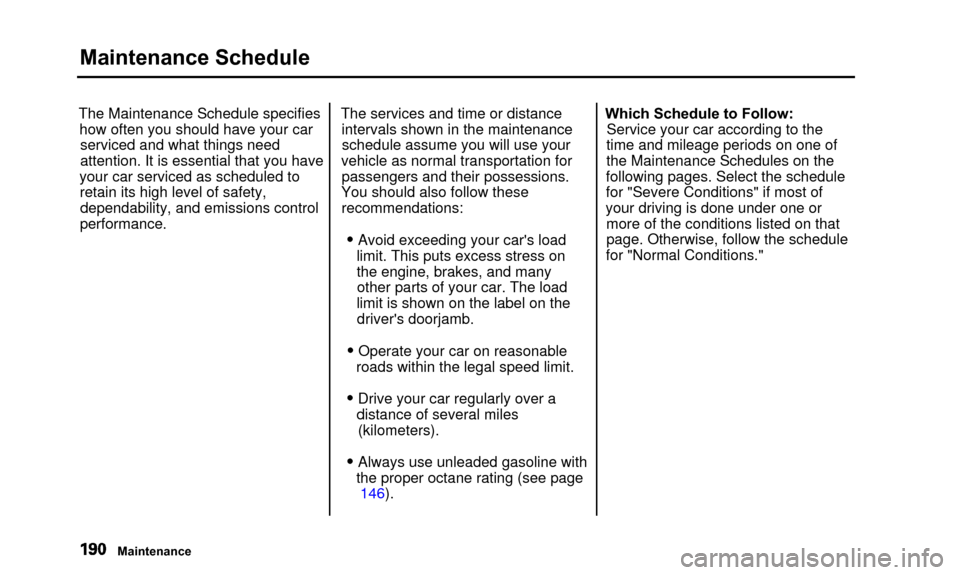
Maintenance Schedule
The Maintenance Schedule specifieshow often you should have your carserviced and what things need
attention. It is essential that you have
your car serviced as scheduled to retain its high level of safety,dependability, and emissions control
performance. The services and time or distance
intervals shown in the maintenanceschedule assume you will use your
vehicle as normal transportation for passengers and their possessions.
You should also follow these recommendations:
• Avoid exceeding your car's load limit. This puts excess stress on
the engine, brakes, and manyother parts of your car. The load
limit is shown on the label on the driver's doorjamb.
• Operate your car on reasonable roads within the legal speed limit.
• Drive your car regularly over a distance of several miles(kilometers).
• Always use unleaded gasoline with the proper octane rating (see page 146). Which Schedule to Follow:
Service your car according to the
time and mileage periods on one of
the Maintenance Schedules on the
following pages. Select the schedule
for "Severe Conditions" if most of
your driving is done under one or more of the conditions listed on that
page. Otherwise, follow the schedule
for "Normal Conditions."
Maintenance
Page 289 of 311
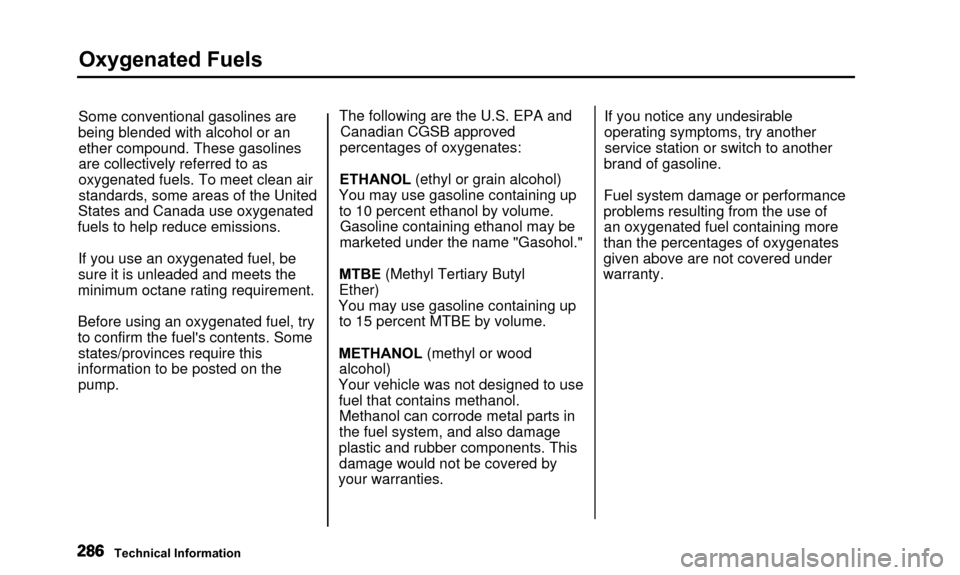
Oxygenated Fuels
Some conventional gasolines are
being blended with alcohol or an ether compound. These gasolines
are collectively referred to as
oxygenated fuels. To meet clean air
standards, some areas of the United
States and Canada use oxygenated
fuels to help reduce emissions.
If you use an oxygenated fuel, be
sure it is unleaded and meets the
minimum octane rating requirement.
Before using an oxygenated fuel, try
to confirm the fuel's contents. Some states/provinces require this
information to be posted on the pump. The following are the U.S. EPA and
Canadian CGSB approved
percentages of oxygenates:
ETHANOL (ethyl or grain alcohol)
You may use gasoline containing up to 10 percent ethanol by volume. Gasoline containing ethanol may be
marketed under the name "Gasohol."
MTBE (Methyl Tertiary Butyl
Ether)
You may use gasoline containing up to 15 percent MTBE by volume.
METHANOL (methyl or wood alcohol)
Your vehicle was not designed to use fuel that contains methanol.Methanol can corrode metal parts in
the fuel system, and also damage
plastic and rubber components. This damage would not be covered by
your warranties. If you notice any undesirable
operating symptoms, try another
service station or switch to another
brand of gasoline.
Fuel system damage or performance
problems resulting from the use of an oxygenated fuel containing more
than the percentages of oxygenates
given above are not covered under
warranty.
Technical Information
Page 290 of 311
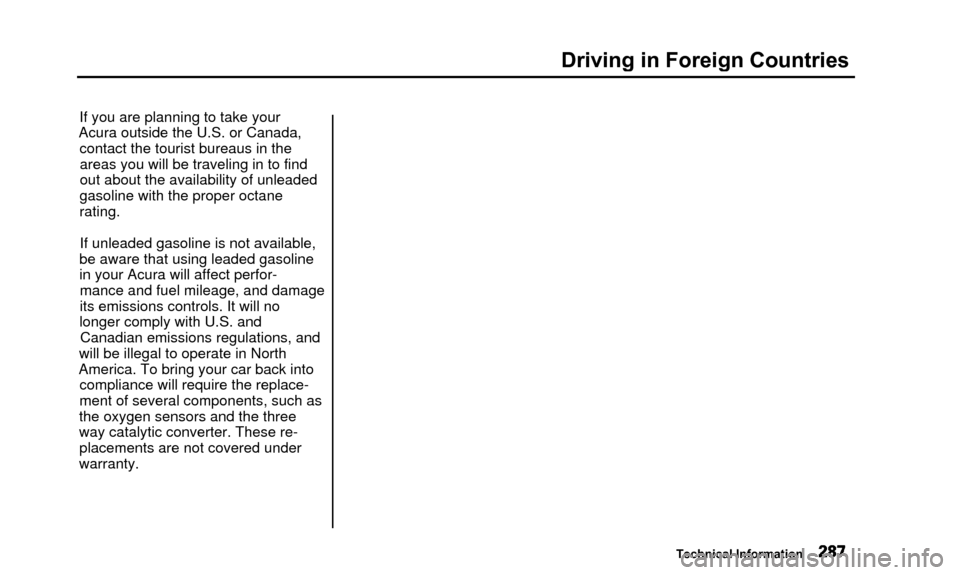
Driving in Foreign Countries
Technical Information
If you are planning to take your
Acura outside the U.S. or Canada, contact the tourist bureaus in theareas you will be traveling in to find
out about the availability of unleaded
gasoline with the proper octane
rating.
If unleaded gasoline is not available,
be aware that using leaded gasoline
in your Acura will affect perfor- mance and fuel mileage, and damage
its emissions controls. It will no
longer comply with U.S. and Canadian emissions regulations, and
will be illegal to operate in North
America. To bring your car back into compliance will require the replace-
ment of several components, such as
the oxygen sensors and the three
way catalytic converter. These re- placements are not covered under
warranty.
Page 305 of 311
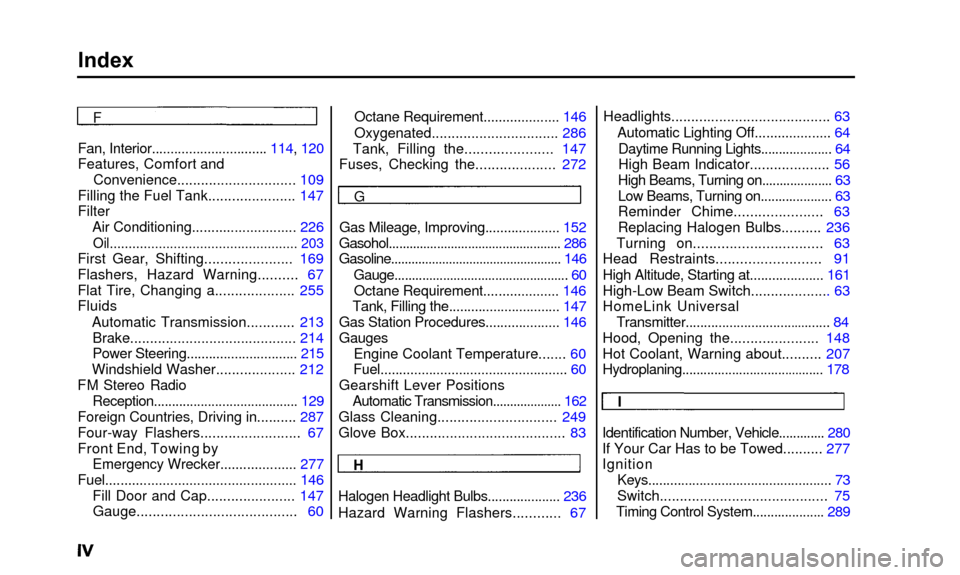
Index
Fan, Interior............................... 114, 120
Features, Comfort andConvenience.............................. 109
Filling the Fuel Tank...................... 147
Filter Air Conditioning.......... ................. 226
Oil.................................................. 203
First Gear, Shifting.......... ............ 169
Flashers, Hazard Warning.......... 67
Flat Tire, Changing a.................... 255
Fluids
Automatic Transmission.. .......... 213
Brake.......... ................................ 214
Power Steering.............................. 215
Windshield Washer.................... 212
FM Stereo Radio Reception........................................ 129
Foreign Countries, Driving in.......... 287
Four-way Flashers......................... 67
Front End, Towing by
Emergency Wrecker.................... 277
Fuel.................................................. 146
Fill Door and Cap...................... 147 Gauge........................................ 60 Octane Requirement..........
.......... 146
Oxygenated.......... ...................... 286
Tank, Filling the.......... ............ 147
Fuses, Checking the.......... .......... 272Headlights.......................................
. 63
Automatic Lighting Off.................... 64 Daytime Running Lights......... ........... 64
High Beam Indicator.................... 56
High Beams, Turning on......... ........... 63
Low Beams, Turning on......... ........... 63
Reminder Chime...................... 63
Replacing Halogen Bulbs.......... 236
Turning on......... ....................... 63
Head Restraints.......................... 91
High Altitude, Starting at.......... .......... 161
High-Low Beam Switch......... ........... 63
HomeLink Universal Transmitter.............................
.......... . 84
Hood, Opening the...................... 148
Hot Coolant, Warning about.......... 207
Hydroplaning.............................
........... 178
F
G
Gas Mileage, Improving.......... .......... 152
Gasohol.................................................. 286
Gasoline.................................................. 146
Gauge......... ........................................ . 60
Octane Requirement.......... .......... 146
Tank, Filling the.......... .................... 147
Gas Station Procedures.................... 146
Gauges
Engine Coolant Temperature... .... 60
Fuel................................................. . 60
Gearshift Lever Positions Automatic Transmission.................... 162
Glass Cleaning.............................. 249
Glove Box....................................... . 83
H
Halogen Headlight Bulbs.................... 236
Hazard Warning Flashers.......... .. 67I
Identification Number, Vehicle............. 280
If Your Car Has to be Towed.......... 277
Ignition
Keys................................................. . 73
Switch......................................... . 75
Timing Control System.......... .......... 289
Page 307 of 311
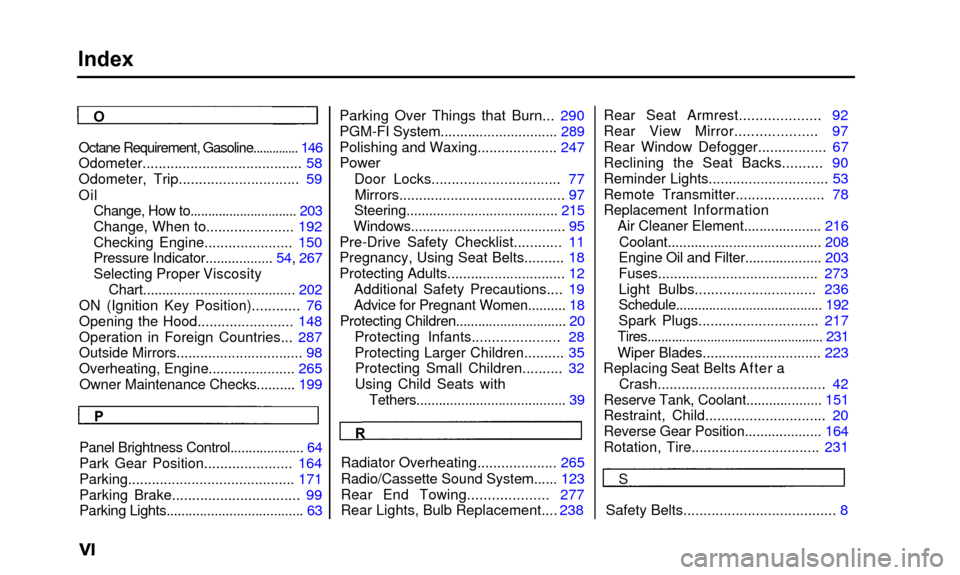
Index
O
Octane Requirement, Gasoline.... .......... 146
Odometer....................................... . 58
Odometer, Trip.............................. 59
Oil Change, How to.......... .................... 203
Change, When to...................... 192
Checking Engine...................... 150
Pressure Indicator......... ......... 54, 267
Selecting Proper Viscosity Chart........................................ 202
ON (Ignition Key Position)......... ... 76
Opening the Hood........................ 148
Operation in Foreign Countries... 287
Outside Mirrors......... ....................... 98
Overheating, Engine...................... 265
Owner Maintenance Checks.......... 199
Parking Over Things that Burn... 290
PGM-FI System.......... .................... 289
Polishing and Waxing.................... 247
Power
Door Locks......... ....................... 77
Mirrors.......................................... 97
Steering.......... .............................. 215
Windows........................................ 95
Pre-Drive Safety Checklist.......... .. 11
Pregnancy, Using Seat Belts.......... 18
Protecting Adults......... ..................... 12
Additional Safety Precautions.... 19
Advice for Pregnant Women.......... 18
Protecting Children......... ..................... 20
Protecting Infants......... ............. 28
Protecting Larger Children.......... 35
Protecting Small Children.......... 32
Using Child Seats with
Tethers......... .............................. . 39Rear Seat Armrest.........
........... 92
Rear View Mirror......... ........... 97
Rear Window Defogger......... ........ 67
Reclining the Seat Backs.......... 90
Reminder Lights......... ..................... 53
Remote Transmitter......... ............. 78
Replacement Information Air Cleaner Element.......... .......... 216
Coolant.......... .............................. 208
Engine Oil and Filter.................... 203
Fuses........................................ 273
Light Bulbs.......... .................... 236
Schedule........................................ 192
Spark Plugs.......... .................... 217
Tires.................................................. 231
Wiper Blades.............................. 223
Replacing Seat Belts After a Crash......... ................................ . 42
Reserve Tank, Coolant.......... .......... 151
Restraint, Child.............................. 20
Reverse Gear Position.......... .......... 164
Rotation, Tire.......... ...................... 231
P
Panel Brightness Control......... ........... 64
Park Gear Position...................... 164
Parking.......................................... 171
Parking Brake................................ 99
Parking Lights.................................... . 63R
S
Radiator Overheating..........
.......... 265
Radio/Cassette Sound System.... .. 123
Rear End Towing.......... .......... 277
Rear Lights, Bulb Replacement.... 238 Safety Belts...................................... 8
Page 311 of 311
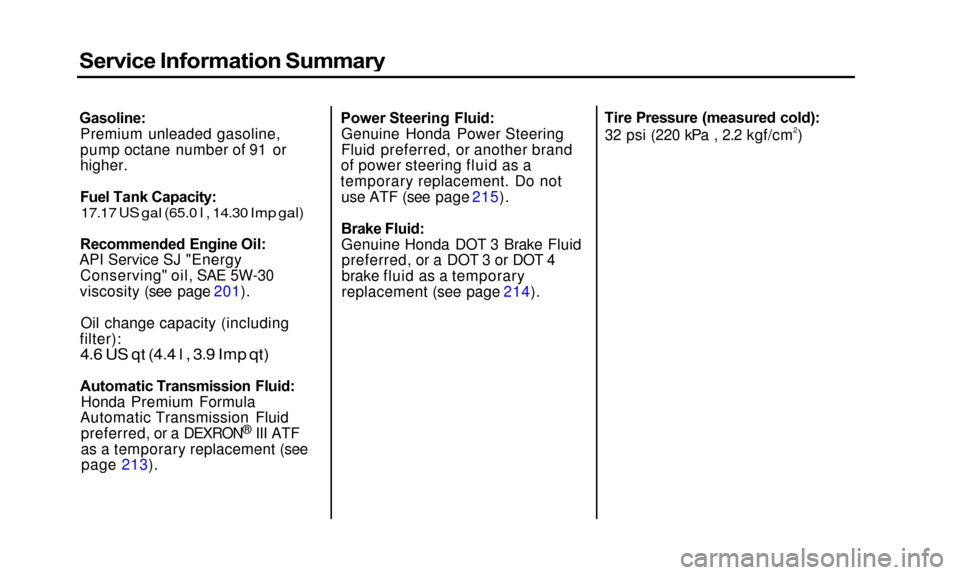
Service Information Summary
Gasoline:
Premium unleaded gasoline,
pump octane number of 91 or
higher.
Fuel Tank Capacity:
17.17 US gal (65.0 l , 14.30 Imp gal)
Recommended Engine Oil:
API Service SJ "Energy Conserving" oil, SAE 5W-30
viscosity (see page 201).
Oil change capacity (including
filter):
4.6 US qt (4.4 l , 3.9 Imp qt)
Automatic Transmission Fluid: Honda Premium Formula
Automatic Transmission Fluid preferred, or a DEXRON
® III ATF
as a temporary replacement (see page 213). Power Steering Fluid:
Genuine Honda Power Steering
Fluid preferred, or another brand
of power steering fluid as a
temporary replacement. Do not use ATF (see page 215).
Brake Fluid:
Genuine Honda DOT 3 Brake Fluidpreferred, or a DOT 3 or DOT 4
brake fluid as a temporary
replacement (see page 214). Tire Pressure (measured cold):
32 psi (220 kPa , 2.2 kgf/cm
2)